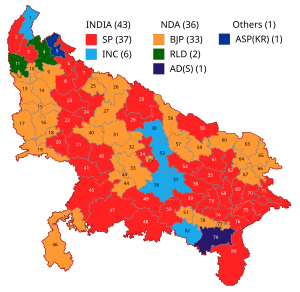Abstract:
On June 4th, 2024, the highly anticipated result of the Indian general election was declared. While the NDA got the majority of seats, it lost ground in many places, and the one in Uttar Pradesh was more moderate. UP, a virtual fortress for the BJP for the past decades was penetrated by the INDI alliance to the shock of everyone. The following paper examines this particular event and how it came to be. Firstly, the paper briefly introduces UP and its importance in Indian politics. Next, the paper delves into the elections held in UP for Lok Sabha throughout the years and the trends that have emerged. After that, the paper does a deep dive into the most recent general election in UP, the circumstances under which the election was held, the shocking result, and how it came to fruition based on caste politics and the different results from the various regions of UP. Following that, the paper analyses the election with the help of 3 different case studies of 3 different constituencies of UP and how analysis of their results holds the key to understanding how this election turned out the way it did. This is followed by an examination of the various strategies followed by the 2 blocs and how it has yielded vastly different results for them both. Finally, the paper sheds light on what the future of UP might hold and how its residents might be affected in coming years, along with the measures the incumbent needs to follow to ensure the results in the next election go in their favour.
Keywords– NDA, BJP, INDI Alliance, UP, Elections.
Introduction:
While the state of Uttar Pradesh is relatively new in our country’s history, the area has a vibrant heritage. Mathura, the birthplace of Lord Krishna, is located in this area. Ayodha, the capital of Lord Rama’s kingdom lies here along with numerous other empires who have called this area their home. With over 25.7 Crore calling it home, U.P. stands as the most populous state in India, being more populated than all but 4 countries. Lok Sabha elections in the U.P. have always been of severe importance. It’s commonly said that ‘the way to Delhi is through UP’, and a party that does well in the state generally goes on to rule India. This is because it elects 80 MPs in the 543-member lower house of parliament (the Lok Sabha). This is why it was considered to be the key to Prime Minister Shri Narendra Modi’s re-election bid as he sought to return for a third consecutive term with BJP getting a thumping victory in the state for the past two elections some pundits had already called the state for the incumbent even before the first vote was cast. On 3rd June when the exit polls were released they all but confirmed the victory of the BJP in the state with almost all news channels forecasting the party to receive 60+ seats. However, as the northern state began counting votes at the dawn of 4th June the actual results turned out to be quite shocking. What was thought to be an easy victory for the Prime Minster’s party turned into a race too close to be called. By the evening the victors had emerged and it wasn’t the incumbent party but in fact, it was the opposition, the INDI alliance, who won 43 out of the possible 80 seats with NDA contending for just 36 seats, 30 less than its tally in 2019. The reasons for this unexpected result are multifaceted with caste, religion, income, and even gender playing a crucial role in BJP’s reckoning. The already fragmented and polarized environment of the state was taken full advantage of by the opposition alliance who ensured that it would emerge as the victor when the dust settled on this election.
Click Here To Download The Paper


📌Analysis of Bills and Acts
📌 Summary of Reports from Government Agencies
📌 Analysis of Election Manifestos

